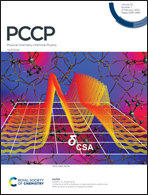Molecular dynamics simulations of copolymer compatibilizers for polylactide/poly(butylene succinate) blends†
Abstract
The effects of the molecular architecture of polylactide (PLA)–poly(butylene succinate) (PBS) copolymers on their compatibilization efficiency in immiscible PLA/PBS blends were studied using atomistic molecular-dynamics simulations. The results showed that the diblock copolymer is the most efficient at mixing with PLA and PBS homopolymers and reducing the interfacial tension of the blend. Tensile properties of the compatibilized blends were examined using uniaxial deformation simulations. Deformation behaviours of the blends at the molecular level were revealed. Both the structure (i.e. linear and branch) and the monomer sequence of the copolymers were found to affect the tensile performance. The system with a diblock copolymer showed a much greater tensile strength and elastic modulus than the other compatibilized blends. Comparing between triblock and graft copolymers, the former yielded the blends with better tensile performance than the latter. Our results suggest that copolymers with a linear structure, especially the diblock one, could be good candidates for the compatibilizer of PLA/PBS blends.



 Please wait while we load your content...
Please wait while we load your content...